Understanding how your ads are performing is critical to optimizing your campaigns for maximum effectiveness.
In today’s digital marketing landscape, which continues to evolve, awareness ads are key to building brand recognition and sparking interest among your target audience.
These campaigns are not about generating clicks; they aim to leave a lasting impression, which makes measuring their success uniquely challenging.
By focusing on specific metrics, you can gain deeper insights into what works and refine your strategies to achieve better results.
In this article, we’ll explore the key metrics that matter for awareness ads and how they help you evaluate performance effectively.
- Understanding Awareness Ads and Their Objectives
- The Role of Metrics in Evaluating Ad Performance
- Top 4 Metrics to Analyze Awareness Ad Performance
- Strategies to Optimize Awareness Ad Performance
- Maintaining Long-Term Success in Awareness Ad Campaigns
- Conclusion: Maximizing Awareness Ad Performance
- Frequently Asked Questions About Analyzing Ad Performance
Understanding Awareness Ads and Their Objectives
Awareness ads are designed to introduce your brand to potential customers who may not be familiar with your products or services.
These ads prioritize visibility and reach, aiming to leave a memorable impression that builds familiarity and trust over time.
Unlike conversion-focused campaigns, awareness ads are not primarily geared towards immediate sales but rather to lay the groundwork for future interactions.
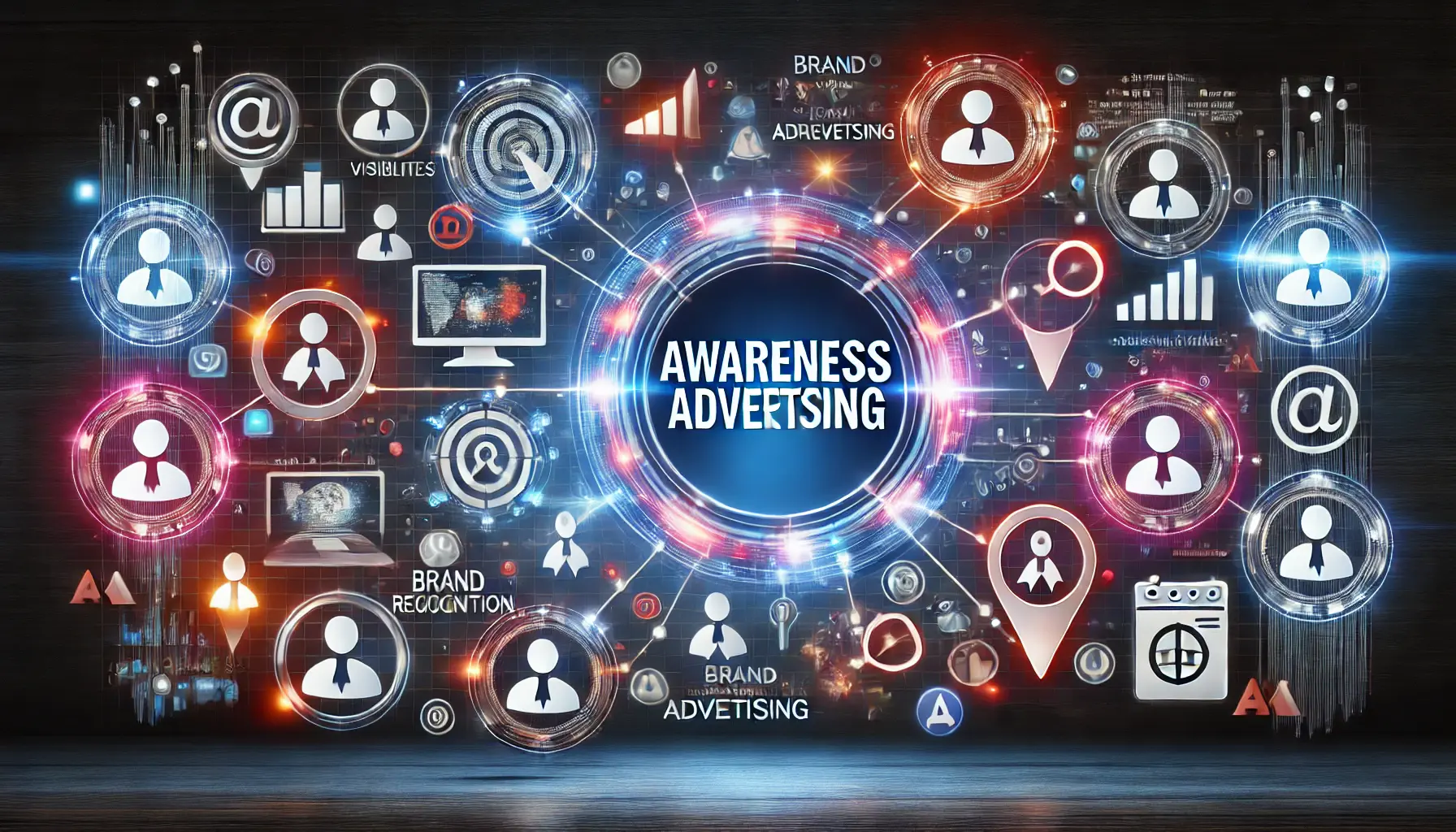
Abstract visualization of awareness advertising and its broad-reaching impact.
What are awareness ads?
Awareness ads are ad campaigns that focus on improving brand visibility rather than necessarily eliciting conversions.
These are usually the first point of contact between your brand and a new audience, thus setting a foundation to build relationships.
- They appear at the top of the sales funnel.
- They create recognition and interest.
- They are visually appealing to gain the attention of their target audience.

Representation of the role of awareness ads in building brand trust and visibility.
Importance of awareness ads in brand campaigns
Without awareness ads, your brand might struggle to stand out in a crowded market.
They play a key role in:
- Establishing your presence among competitors.
- Creating emotional connections with your audience.
- Laying the groundwork for customer loyalty and repeat engagement.
In short, awareness ads are the first step in turning strangers into loyal customers.
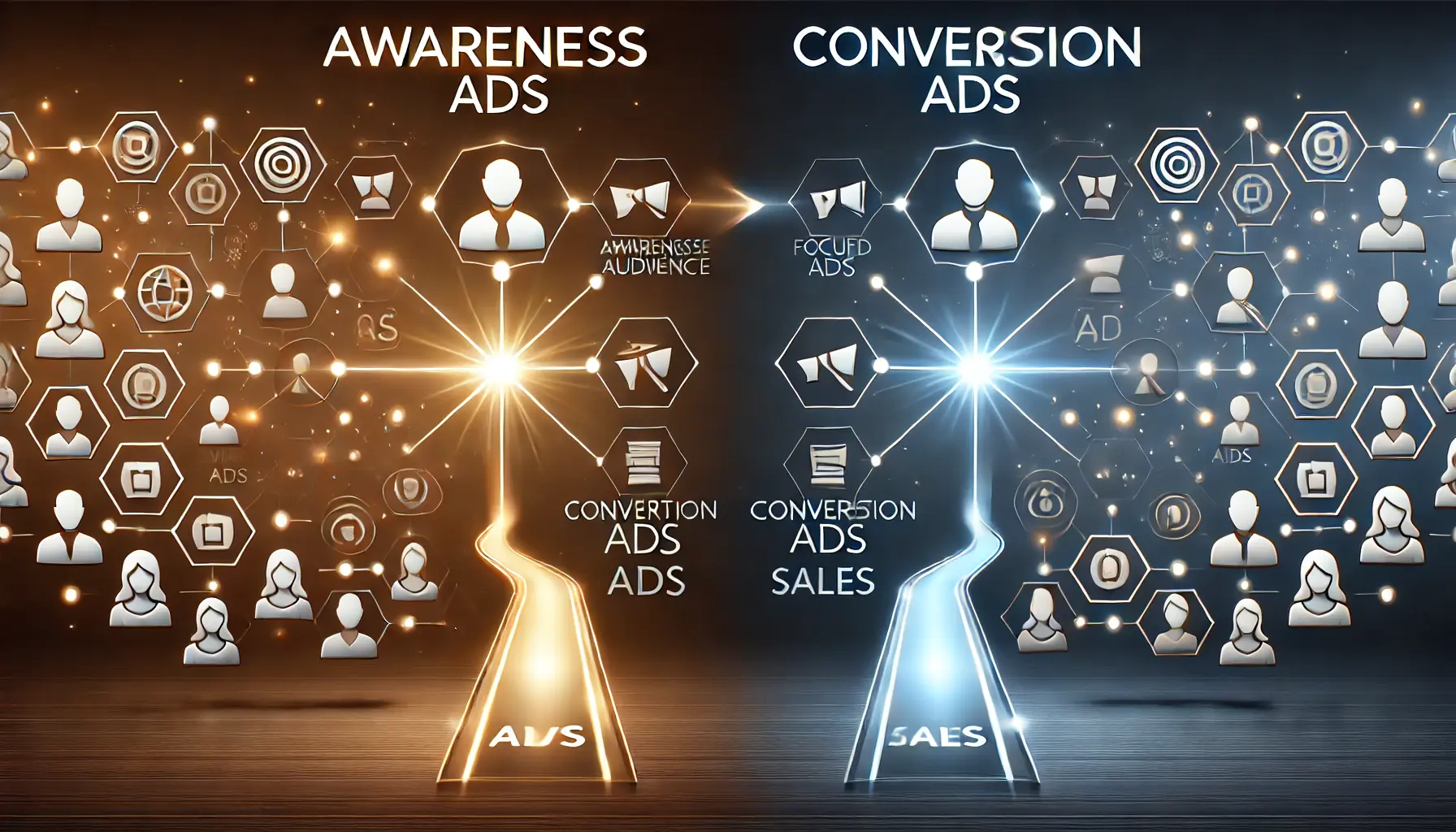
Visual representation of the differences between awareness and conversion-focused ads.
Key differences between awareness and conversion-focused ads
It’s essential to distinguish awareness ads from conversion-focused campaigns to measure their success appropriately.
Key differences include:
- Goal: Awareness ads aim to inform, while conversion ads aim to sell.
- Metrics: Metrics like reach and impressions matter more for awareness campaigns.
- Audience: Awareness ads target a broader audience, while conversion campaigns target specific segments ready to act.
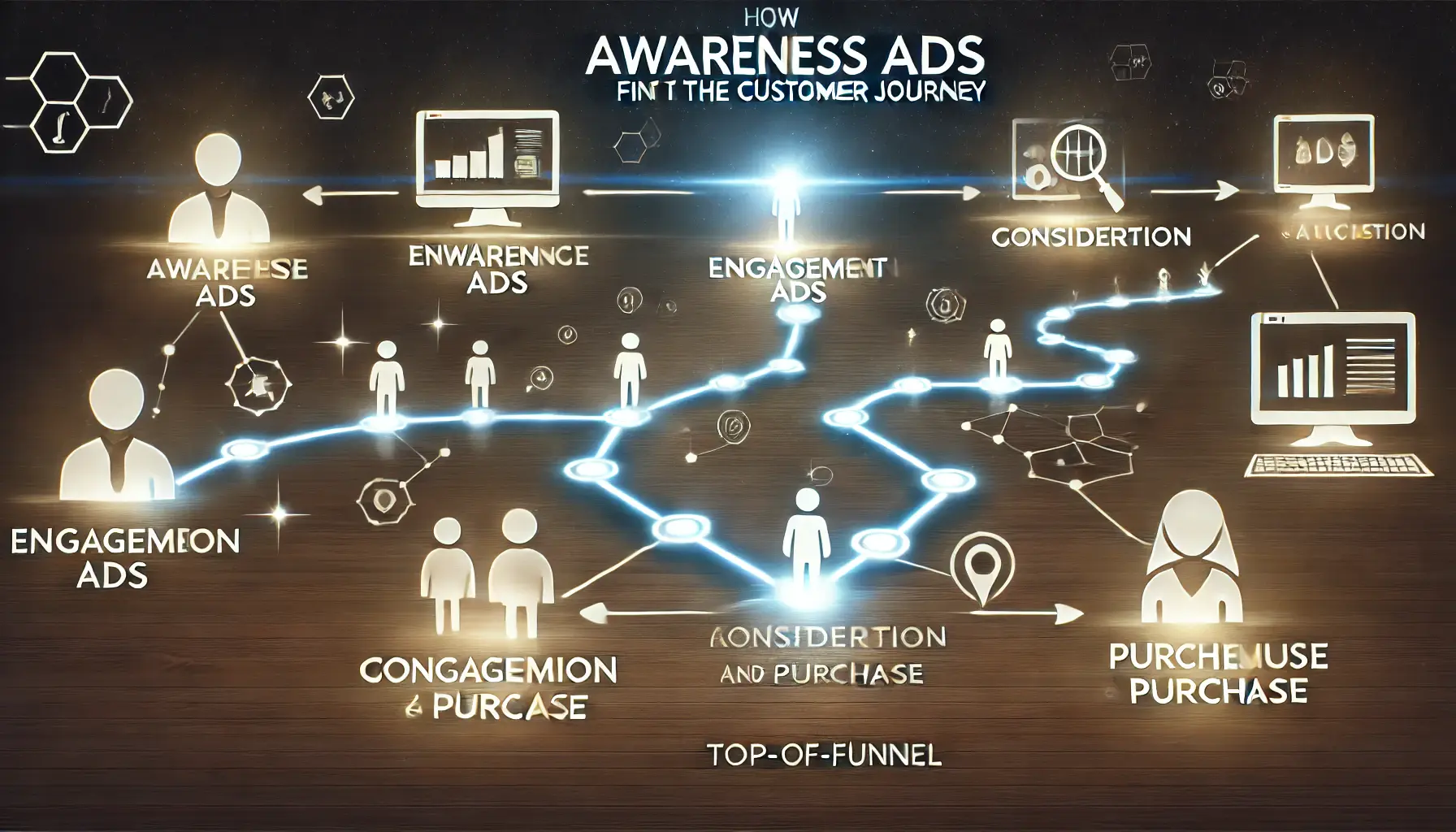
Representation of awareness ads as the starting point in the customer journey.
How awareness ads fit into the customer journey
Awareness ads are an integral part of the customer journey.
They occupy the top-of-funnel stage, where potential customers first learn about your brand.
By creating a positive impression, awareness ads make it easier for customers to recognize and recall your brand during their decision-making process.
Now that we’ve laid the groundwork for understanding awareness ads, we’ll dive into the specific metrics that help measure their performance in the next section.
Awareness ads are essential for building brand recognition, prioritizing visibility and trust over immediate sales.

Visual depiction of metrics’ importance in assessing ad performance.
The Role of Metrics in Evaluating Ad Performance
In the realm of digital marketing, tracking metrics is essential for understanding and enhancing the effectiveness of your awareness ad campaigns.
By diligently monitoring these metrics, you can gain valuable insights into how well your ads are resonating with your target audience and make informed decisions to optimize your strategies.
However, measuring the success of awareness ads presents unique challenges.
Unlike direct response campaigns, where conversions are easily quantifiable, awareness campaigns focus on building brand recognition and interest, making their impact less straightforward to assess.
This complexity requires a nuanced approach to evaluation.
Visual representation of the critical role of metrics in awareness campaigns.
Why Tracking Metrics is Crucial for Awareness Campaigns
Monitoring key performance indicators (KPIs) allows you to:
- Measure Reach and Engagement: Understand how many people are exposed to your ads and how they engage with them.
- Optimize Spend: Identify which channels and messages drive the best results to optimize your marketing spend.
- Sharpen Targeting: Understand the behaviors and preferences of your audiences to better target your ads more precisely.
By focusing on these aspects, you can ensure that your awareness campaigns are not only reaching a broad audience but also engaging them in meaningful ways.

Visual representation of the complexities in measuring the effectiveness of awareness ads.
Challenges in Measuring Awareness Ad Effectiveness
Several factors complicate the evaluation of awareness ads:
- Intangible Outcomes: Metrics like brand perception and recall are subjective and harder to quantify.
- Extended Timeframes: The impact of awareness campaigns often unfolds over a longer period, delaying observable results.
- Attribution Difficulties: Determining which ad exposures lead to changes in consumer behavior can be complex due to multiple touchpoints.
Recognizing these challenges is the first step toward developing more effective measurement strategies for your awareness campaigns.

Visual representation of the misunderstandings surrounding ad performance metrics.
Common Misconceptions About Ad Performance Metrics
It’s important to address prevalent misunderstandings, such as:
- Overreliance on Click-Through Rates (CTR): CTR only accounts for immediate interest and does not reflect the full picture in terms of brand awareness or long-term engagement.
- Lack of Qualitative Insights: Exclusively relying on quantitative information may miss important qualitative feedback that could show more profound audience sentiments.
A balanced approach using both quantitative and qualitative data provides a more comprehensive understanding of your ad performance.

Visual representation of balancing qualitative and quantitative data in marketing analysis.
Balancing Qualitative and Quantitative Data
In assessing awareness ads, one can consider combining:
- Quantitative Metrics: Impressions, reach, and engagement rates measure the magnitude of exposure and interaction that your ad received.
- Qualitative Feedback: Insights through surveys, focus groups, and social media listening reveal audience perception and attitudes toward your brand.
This integrated approach lets you capture a well-rounded view of the impact of your ad to make better strategic decisions in your marketing efforts.
By understanding the role of metrics in measuring ad performance, along with the inherent challenges associated with it, you will be better placed to create more effective awareness campaigns that cut through the noise to deliver your brand objectives.
Tracking metrics like reach, impressions, and engagement helps refine your strategies for better ad performance.
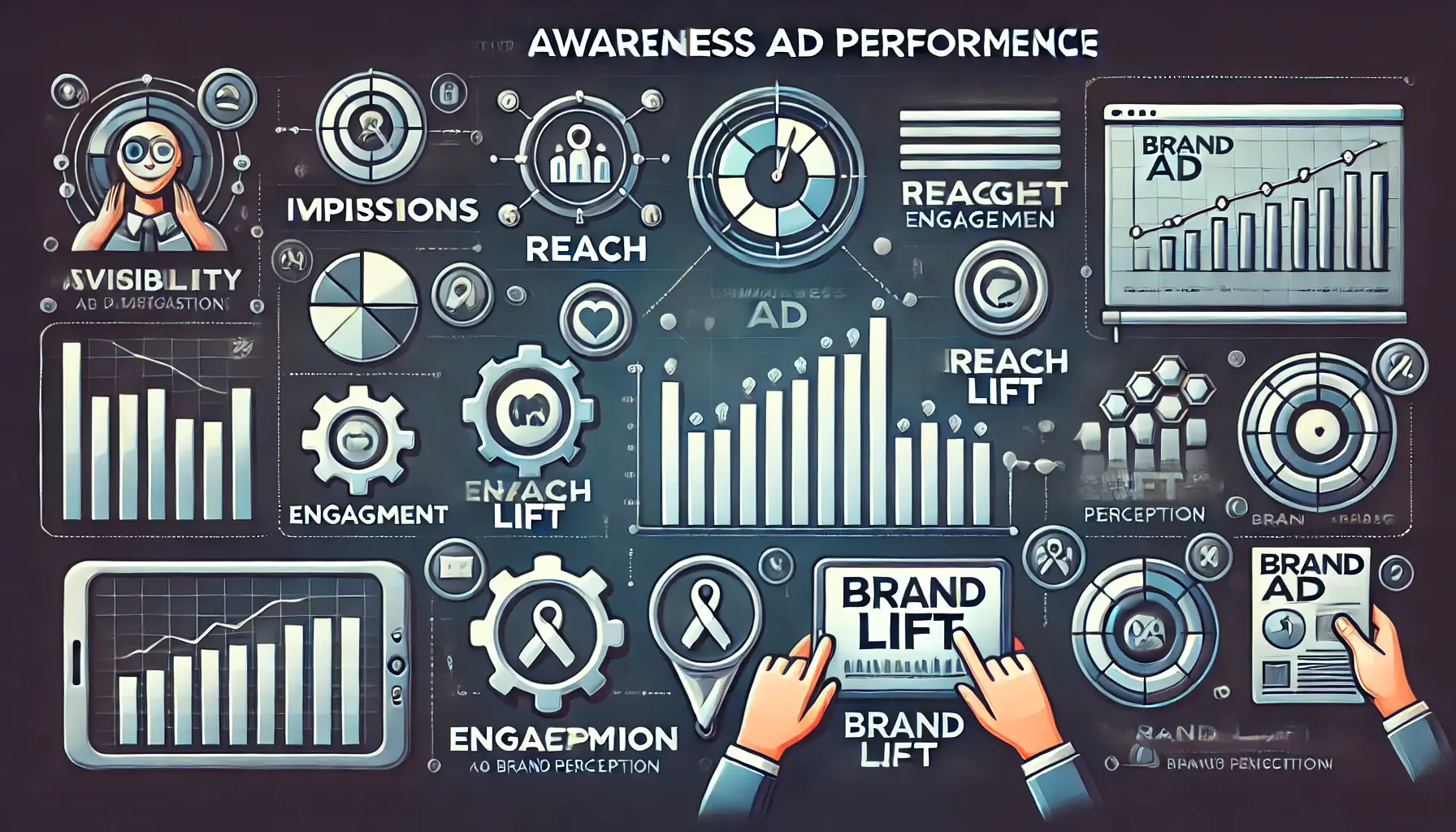
Visual representation of key metrics used to analyze awareness ad performance.
Top 4 Metrics to Analyze Awareness Ad Performance
Evaluating the effectiveness of your awareness ads requires focusing on specific metrics that provide insights into how well your message is reaching and resonating with your target audience.
Here are four key metrics to consider:

Visual representation of impressions as a metric for gauging ad visibility.
1. Impressions: Gauging Visibility
Impressions represent the total number of times your ad is displayed to users.
This metric helps you understand the extent of your ad’s exposure.
- High Impressions: Indicate that your ad is being shown frequently, increasing the likelihood of brand recognition.
- Low Impressions: May suggest the need to adjust your ad placement or targeting strategies to enhance visibility.
Monitoring impressions allows you to assess whether your ads are achieving the desired level of exposure to build brand awareness.

Visual representation of reach and audience scope in advertising.
2. Reach: Understanding Audience Scope
Reach measures the number of unique users who have viewed your ad at least once.
It gives insight into how many individuals are being exposed to your brand.
- Strong Broad Reach: Expands your brand across a larger audience.
- Low Reach: Indicates that your targeting might be too narrow and may limit the scale of your ad.
By studying reach, you understand whether your awareness campaign is successfully reaching a variety of audiences.

Visual representation of engagement and interaction levels in advertising.
3. Engagement: Measuring Interaction Levels
Engagement is an action taken by users when they like, share, comment, or click through on your ad.
The more the engagement, the more your ad resonates with the audience.
- High Engagement Rates: Indicate great interest from the audience and may increase organic reach when people share and discuss your content.
- Low Engagement Rates: Suggest that your ad may not be compelling enough, necessitating creative adjustments.
Tracking engagement helps you understand the effectiveness of your ad content in fostering audience interaction.

undefined
4. Brand Lift: Assessing Audience Perception Shifts
Brand lift measures the increase in audience perception and awareness of your brand after being exposed to your ad.
It evaluates changes in metrics such as brand recall, favorability, and purchase intent.
- Positive Brand Lift: This means your ad is helping to improve brand perception and consideration.
- Negative or No Brand Lift: This might require a reassessment of your ad messaging and targeting to better align with audience expectations.
Assessing brand liftA measure of the increase in audience perception and awareness of a brand after exposure to an ad. provides a deeper understanding of how your awareness ads influence consumer attitudes toward your brand.
By focusing on these four metrics—impressions, reach, engagement, and brand lift—you will have a full understanding of your awareness ad performance and will be able to make informed decisions toward the optimization of your campaigns for better brand recognition and audience connection.
Focus on impressions, reach, engagement, and brand lift to assess your awareness ads effectively.
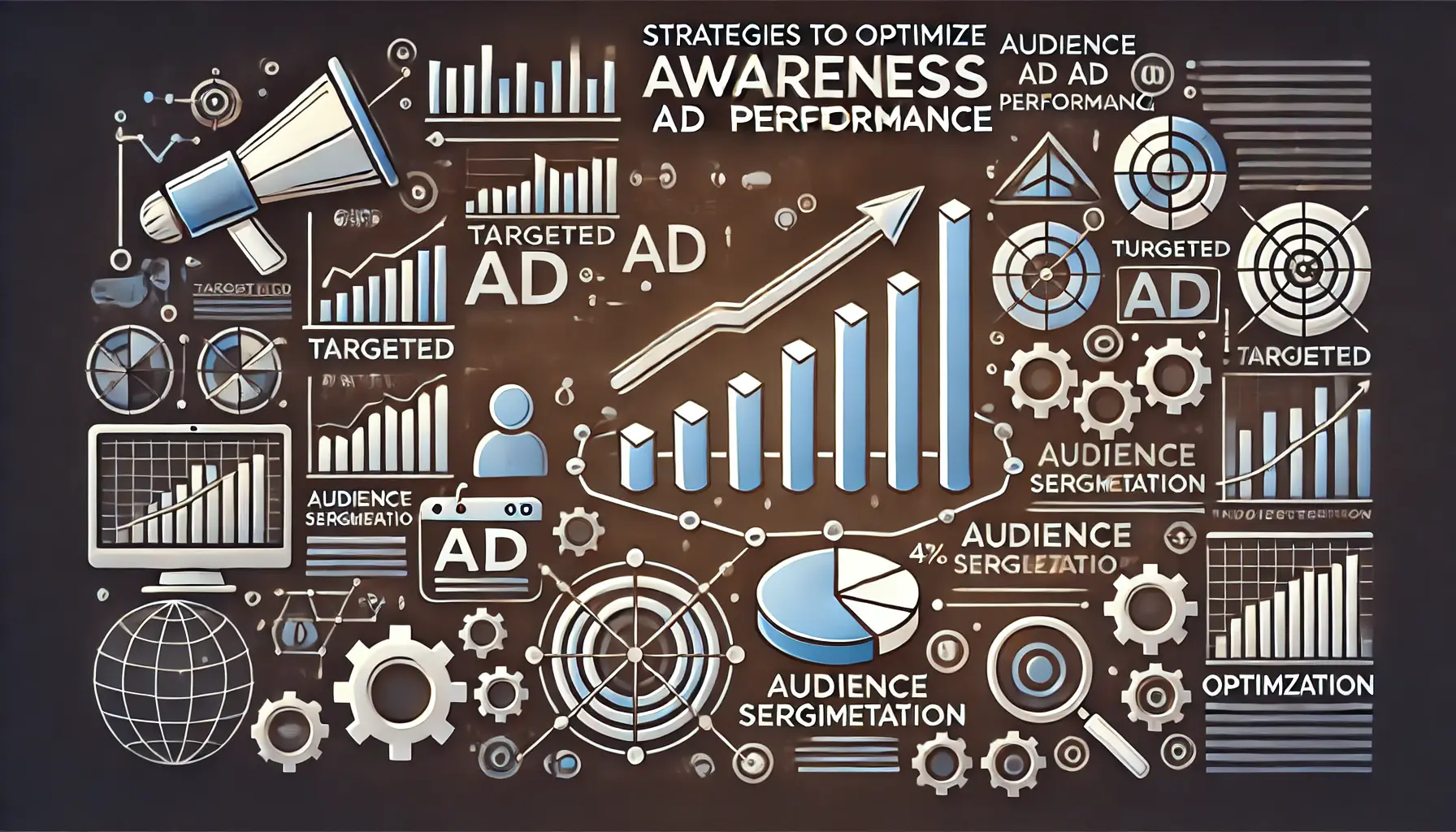
Visual representation of strategies to optimize awareness ad performance.
Strategies to Optimize Awareness Ad Performance
Enhancing the effectiveness of your awareness ads involves implementing targeted strategies that align with your brand objectives and resonate with your audience.
Here are key approaches to consider:

Visual representation of rich-media ad formats like interactive videos and animated banners.
1. Leverage Rich-Media Ad Formats
Rich-media ad formats can significantly increase the level of audience engagement.
Static images, HTML5The latest version of the Hypertext Markup Language used for structuring and presenting content on the web. animations, and video ad formats hold great potential to attract views and ensure more interaction.
With the Google Display Network supporting these varied formats, it becomes easier to create stunning ads that contribute to brand recognition.

Visual representation of target frequency campaigns in digital marketing.
2. Use Target Frequency Campaigns
Managing how often your audience sees your ads is crucial for maintaining interest without causing ad fatigue.
Google Ads offers a ‘Target frequency’ feature that allows you to set the desired number of impressions per user over a specified period.
This strategy ensures consistent brand exposure, effectively reinforcing your message.

Visual representation of audience segmentation for targeted ad campaigns.
3. Utilize Audience Segmentation
Audience segmentation enables you to tailor your ads to specific groups based on demographics, interests, and behaviors.
By creating custom segments, you can reach users who are more likely to be interested in your brand, thereby increasing the relevance and impact of your ads.
Google Ads provides tools to define and target these segments, enhancing campaign precision.

Visual representation of monitoring and adjusting bidding strategies in digital advertising.
4. Monitor and Adjust Bidding Strategies
Effective bidding is essential to maximize the reach and efficiency of your awareness campaigns.
Explore automated bidding options where strategies align with your goals, such as ‘Maximize Impressions’ or ‘Reach.’ Regularly reviewing and adjusting your bids ensures optimal ad placement and budget utilization.
By implementing these approaches, you can boost the efficiency of your awareness ads, leading to greater brand visibility and more audience engagement.
Implement rich-mediaInteractive advertising formats, such as animations or videos, that enhance engagement. ad formats, target frequency campaigns, and audience segmentation to boost visibility and interaction.

Visual representation of sustaining growth and long-term success in awareness ad campaigns.
Maintaining Long-Term Success in Awareness Ad Campaigns
Ensuring sustained success in your awareness ad campaigns requires a strategic approach that adapts to evolving market dynamics and consumer behaviors.
Here are key strategies to consider:

Visual representation of continuous monitoring and optimization in digital marketing.
1. Continuous Monitoring and Optimization
Regularly track your ad performance metrics to identify areas for improvement.
Utilize tools like Google Analytics to gain insights into user behavior and campaign effectiveness.
This data-driven approach enables you to make informed decisions and refine your strategies over time.

Visual representation of diversifying ad formats and channels in digital marketing.
2. Diversify Ad Formats and Channels
Engage your audience across multiple platforms and formats.
Run a mix of display ads, video content, and social media promotions to reach a wider audience and reinforce your brand message through multiple touchpoints.

Visual representation of A/B testing in digital marketing.
3. Run A/B Testing
Run A/B tests to compare different ad creatives, headlines, and calls-to-action.
Such testing will help you find out what works best for your audience and let you optimize your ads for better performance.

Visual representation of audience engagement in digital marketing.
4. Focus on Audience Engagement
Encourage interaction with your ads by creating compelling content that prompts likes, shares, comments, and clicks.
High engagement rates indicate that your message is resonating, leading to increased brand awareness and loyalty.

Visual representation of adapting to market trends in digital marketing.
5. Adapt to Market Trends
Stay informed about industry trends and consumer preferences.
Flexibility in your advertising approach allows you to capitalize on emerging opportunities and maintain relevance in a constantly changing market.
By implementing these strategies, you can ensure that your awareness ad campaigns remain effective long-term, fostering continuous growth for your brand and building a strong bond with your target audience.
Consistent monitoring, adapting to trends, and engaging content ensure sustained effectiveness of your ad campaigns.
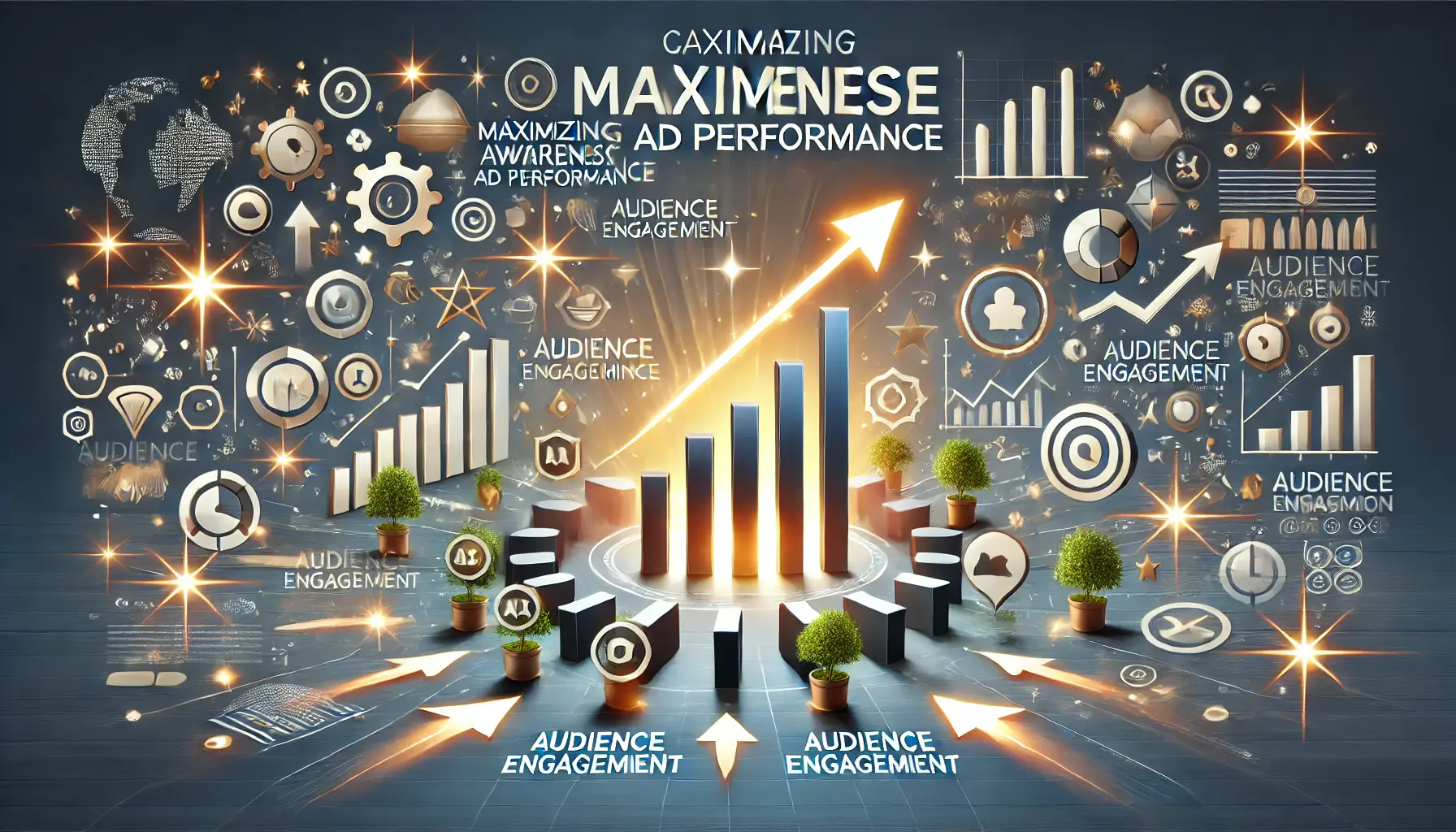
Visual representation of maximizing awareness ad performance in digital marketing.
Conclusion: Maximizing Awareness Ad Performance
Crafting and optimizing awareness ads is an essential strategy for businesses aiming to build brand recognition and connect with their audience effectively.
By leveraging key metrics, implementing targeted strategies, and staying adaptable, your campaigns can achieve both immediate and long-term success.
Let’s summarize the critical takeaways from this guide:

Visual representation of how key metrics drive campaign insights in digital marketing.
Key Metrics Drive Campaign Insights
Understanding ad performance begins with focusing on essential metrics.
Impressions, reach, engagement, and brand lift are pivotal in assessing how well your awareness ads resonate with your audience.
These metrics offer actionable insights into visibility, audience interaction, and perception shifts, enabling more informed decision-making.

Visual representation of strategies to enhance ad performance in digital marketing.
Strategies to Enhance Ad Performance
To optimize the performance of your campaigns, consider employing these strategies:
- Leverage Rich-Media Formats: Engage audiences with visually appealing and interactive ad content.
- Set Target Frequencies: Manage ad exposure to prevent viewer fatigue and reinforce your message effectively.
- Utilize Audience Segmentation: Reach relevant users by tailoring campaigns to specific demographics and interests.
- Adjust Bidding Strategies: Use automated bidding to maximize impressions and ensure budget efficiency.

undefined
Ensuring Long-Term Success
Success in awareness campaigns is maintained through constant effort.
Continuous monitoring and optimization, ad format diversification, A/B testing, and keeping updated with market trends are some of the ways to make your campaigns relevant and effective.
Engaging content that resonates with your audience fosters stronger connections and sustained growth.
In short, awareness ads remain one of the most valuable tools to elevate brands and build trust with audiences.
Continuously evaluate the metrics of ad performance and refine your strategies for maximum impact.
Whether through innovative ad formats or adaptability, the goal is to create a lasting and memorable brand recall for your target audience.
Leverage metrics and strategies to craft impactful awareness campaigns, fostering brand recognition and trust.

Visual representation of FAQs on analyzing ad performance in digital marketing.
Your campaigns can be managed by an agency specialized in Google Ads, check out our service page.
Frequently Asked Questions About Analyzing Ad Performance
Understanding how to measure and enhance ad performance is crucial for effective marketing.
Below are common questions and concise answers to guide you in analyzing your ad campaigns.
Essential metrics include impressions, reach, engagement rates, click-through rates (CTRClick-Through Rate, a metric that measures the percentage of users who click on an ad after viewing it.), conversion rates, and return on ad spend (ROASReturn on Ad Spend, a metric to evaluate the revenue generated for each dollar spent on advertising.).
These indicators help assess visibility, audience interaction, and campaign profitability.
Impressions count the total number of times your ad is displayed, while reach measures the number of unique users who have seen your ad at least once.
Engagement rate indicates how actively your audience interacts with your ad content, reflecting its relevance and effectiveness in capturing attention and fostering interest.
Utilize metrics like brand lift studies, surveys, social media listening, and track changes in direct traffic to assess shifts in brand perception and awareness levels.
CTR measures the percentage of users who click on your ad after viewing it, indicating the ad’s ability to drive traffic to your intended destination.
Enhance ad creatives, target the right audience segments, optimize ad placements, and monitor performance metrics to make data-driven adjustments for better results.
ROAS calculates the revenue generated for every dollar spent on advertising, helping determine the financial effectiveness of your ad campaigns.
Regular analysis, such as weekly or bi-weekly, allows for timely optimizations and ensures your campaigns remain aligned with marketing objectives.
Yes, qualitative insights from customer feedback, surveys, and social media comments provide context to quantitative metrics, offering a comprehensive view of ad effectiveness.












